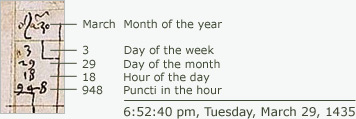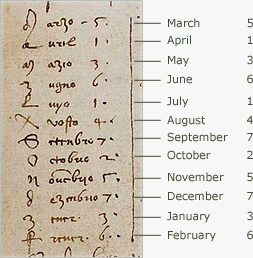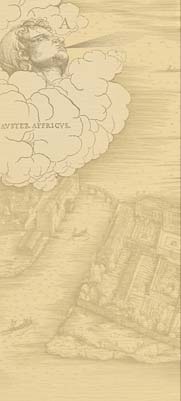Time Reckoning: Toolkit
The Table of Solomon
Michael used many different tools for many different tasks. One element in his time-reckoning toolkit was a Table of Solomon, named for the biblical King Solomon, who was often credited with advanced knowledge in the Middle Ages. Tables like these put a great deal of information at Michael's fingertips.
How does the table work? See how Michael determined:
The date and time of the new moon
Michael's Table of Solomon allowed him to determine the date and time of the new moon for every year from 1435 (when he was writing his manuscript) to 1530.
Below are two rows from the table. These are the rows for 1435 and 1436, as identified in the cell on the far right. The first 12 cells in each row represent the months of the year. The first cell is for March, because March 1 marked the start of the new year in the Julian calendar used in Venice. Other cities and states began the year on other days, including March 24, September 1, and December 25. It's easy to see how complicated a task it was to keep track of time, especially when moving from port to port.
Each individual cell in a row contains detailed information about the time of the true new moon for that month, as Michael would actually observe it. Below is the cell for March 1435.

The number 3 in the cell represents the day of the week of the new moon. Since the week started on Sunday in Michael's time, the third day was a Tuesday. The number 29 represents the calendar day of the new moon, March 29. The number 18 represents the 18th hour of a 24-hour day, or 6:00 p.m. The hour was divided into 60 minutes, but instead of seconds each minute was divided into 18 points, or puncti. An hour thus had 1,080 puncti, so 948 puncti would have been 52 and 2/3 minutes. So 948 puncti after 6 p.m. would be 18:52:40 in modern reckoning.
From the table, therefore, Michael knew the new moon would arrive at exactly 6:52:40 p.m. on Tuesday, March 29, 1435. He could tell the date and time of the new moon for any other month with equal precision. Knowing the date of the moon allowed Michael to predict tides and the hours of daylight and moonlight for any given day. This was important information for voyagers.
The day of the week
The Table of Solomon provided Michael with a special number that he could use to calculate the weekday of any calendar day in a given year. This number was contained in the cell at the right of each row. Below is the far right cell for 1435.

The special number is in the box at the upper right. Michael called this number the patta dela man, or "epact of the hand." We would now call it the concurrent for the year. In Michael's time, the concurrent was the number of the weekday of March 24 each year. In 1435, March 24 was a Thursday, the fifth day of the week, so the concurrent was 5.
To determine the weekday of another calendar day, Michael needed an additional number, which he called a nomen, and we would call a regular. Michael lists the regulars later in his manuscript. The same numbers were used for each month every year. Michael's list of regulars is below.

Two steps were required to determine the weekday of any calendar day:
Step one was to determine the number of the first day of the month in question. The basic rule was to add the concurrent for the year to the regular for the month. If the result was less than or equal to 7, that was the number of the day. If the result was larger than 7, the rule was to divide the number by 7 and use the remainder as the day of the week.
For example, to find the weekday of April 1, 1435, Michael added the concurrent 5 to the regular 1. The result was 6, so April 1 was a Friday. To find the weekday of May 1, Michael added the concurrent 5 to the regular 3. The answer was 8. Dividing by 7 gave a remainder of 1. So May 1, 1435, was a Sunday.
Step two was to add the number of the day for the first of the month to the number of days remaining between the first and the day of the month being sought. This is the same as adding the number for the first of the month to the day of the month, then subtracting 1 (for the first day). If the answer was greater than 7, the rule was to divide by 7 and use the remainder as the day of the week.
For example, take May 24, 1435. May 1 was a Sunday, so add 1 to 24, then subtract 1 for the first day. The answer is 24. Divide by 7. The remainder is 3. So May 24 was a Tuesday that year.
What day would American Thanksgiving have been in 1435? We start by finding the weekday of November 1, adding the concurrent 5 to the regular 5 and dividing by 7. The remainder is 3, so November 1, 1435, was a Tuesday. We remember that Thanksgiving always falls on the fourth Thursday of November. Counting forward from Tuesday, November 1, we know that the first Thursday was November 3. We then add three more weeks, or 21 days. In 1435, American Thanksgiving would have fallen on November 24.
How about Christmas day in 1435? To get the first of December, we add the concurrent 5 to the regular 7. The answer is 12. Divide by 7. The remainder is 5, so December 1 was a Thursday. Next we add the number for the weekday of the first of the month, which was 5, to 25 and subtract 1 for the first of the month. The answer is 29. Divide by 7. The remainder is 1. So Christmas in 1435 fell on a Sunday.
Much of Michael's time-reckoning material is like this. You don't have to know why. Just follow the rule, and you'll get the answer. It's a testament to Michael's curiosity that he often pursued a greater understanding.
The date of Easter
The Table of Solomon provided Michael with the correct date of Easter, which in Michael's time was the holiest day of the year. Early Church fathers decided that the day of Christ's resurrection should always be celebrated on the correct day of the week, rather than on a fixed date like Christmas. Easter, they ruled, must always be on a Sunday after the first full moon following the spring equinox. It could therefore fall in March or April. The exact rules for determining Easter were a matter of doctrinal dispute throughout the Middle Ages, as they are today, and separate practices would have been observed in different places Michael visited. His tables reflect the Roman method of calculation.
The cell at the far right of each row in the table gives three different pieces of information about Easter. Below is the cell for 1435.

The a next to the year indicates that in 1435, Easter was in April. March would have been shown with an m. The box at the lower left gives the date of the Easter full moon as April 15. Using the rules above for determining weekdays, we know that April 15 was a Friday, so the Sunday immediately following was appropriate for Easter. Easter in 1435 was April 17, as written to the right of 15.
There is, however, an oddity. This part of the table says the full Easter moon fell on April 15. If so, the corresponding new moon should have been 14 days earlier, on April 2. But the very first cell in the table at the top of this page tells us that the new moon actually fell on March 29. Why the discrepancy?
The explanation is that the main part of Michael's table gives us the true astronomical new moons, but the year cell on the right gives the moon as it was calculated according to the ecclesiastical, or Church, calendar. To make sure all Christians everywhere in the world could celebrate Easter on the same day, these calculations were based on the assumption that the spring equinox was always March 21, as well as on a fixed but inaccurate length of a theoretical or notional lunar moon. The result was that the church's calendar date for Easter Sunday was not always the same Sunday you would have chosen after observing the actual moon in the sky.
Worse still, the Julian calendar year was inaccurate, losing one day against the actual orbit of Earth every 128 years. As a result, the theoretical equinox of March 21 drifted later and later each year when compared with the real equinox. By Michael's time, the difference was already more than three days.
As a result, anyone observing the actual moon—or armed with a Table of Solomon—could tell that the holiest day in the Christian calendar was not being celebrated on the right date. This scandal would not end until the Gregorian reforms of 1582 gave us the calendar we use today.












